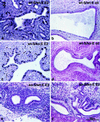Stromal estrogen receptors mediate mitogenic effects of estradiol on uterine epithelium
- PMID: 9177253
- PMCID: PMC21085
- DOI: 10.1073/pnas.94.12.6535
Stromal estrogen receptors mediate mitogenic effects of estradiol on uterine epithelium
Abstract
Estradiol-17beta (E2) acts through the estrogen receptor (ER) to regulate uterine growth and functional differentiation. To determine whether E2 elicits epithelial mitogenesis through epithelial ER versus indirectly via ER-positive stromal cells, uteri from adult ER-deficient ER knockout (ko) mice and neonatal ER-positive wild-type (wt) BALB/c mice were used to produce the following tissue recombinants containing ER in epithelium (E) and/or stroma (S), or lacking ER altogether: wt-S + wt-E, wt-S + ko-E, ko-S + ko-E, and ko-S + wt-E. Tissue recombinants were grown for 4 weeks as subrenal capsule grafts in intact female nude mice, then the hosts were treated with either E2 or oil a week after ovariectomy. Epithelial labeling index and ER expression were determined by [3H]thymidine autoradiography and immunohistochemistry, respectively. In tissue recombinants containing wt-S (wt-S + wt-E, wt-S + ko-E), E2 induced a similar large increase in epithelial labeling index compared with oil-treated controls in both types of tissue recombinants despite the absence of epithelial ER in wt-S + ko-E tissue recombinants. This proliferative effect was blocked by an ER antagonist, indicating it was mediated through ER. In contrast, in tissue recombinants prepared with ko-S (ko-S + ko-E and ko-S + wt-E), epithelial labeling index was low and not stimulated by E2 despite epithelial ER expression in ko-S + wt-E grafts. In conclusion, these data demonstrate that epithelial ER is neither necessary nor sufficient for E2-induced uterine epithelial proliferation. Instead, E2 induction of epithelial proliferation appears to be a paracrine event mediated by ER-positive stroma. These data in the uterus and similar studies in the prostate suggest that epithelial mitogenesis in both estrogen and androgen target organs are stromally mediated events.
Figures





References
-
- Bigsby R M, Aixin L, Luo K, Cunha G R. Endocrinology. 1990;126:2592–2596. - PubMed
-
- Clark J H, Peck E J. Female Sex Steroids: Receptors and Function. New York: Springer; 1979. - PubMed
-
- Medlock K L, Sheehan D M, Branham W S. J Steroid Biochem. 1981;15:283–288. - PubMed
-
- Stumpf W, Sar M. In: Receptors and Mechanism of Action of Steroid Hormones. Pasqualini J, editor. New York: Dekker; 1976. pp. 41–84.
-
- Cunha G R, Shannon J M, Vanderslice K D, Sekkingstad M, Robboy S J. J Steroid Biochem. 1982;17:281–286. - PubMed
Publication types
MeSH terms
Substances
Grants and funding
LinkOut - more resources
Full Text Sources
Research Materials

